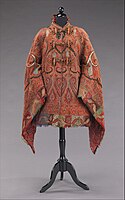Dolman
A dolman is either a military shirt, or a jacket decorated with braiding, first worn by Hungarian hussars. The word is of Turkish origin, and after being adopted into Hungarian, has propagated to other languages. The garment was worn by peasants from the 16th century onward and eventually spread throughout the country, mainly within wealthy peasant circles. It reached people living in the poorest conditions only at the end of the 19th century.
Military dolman
The dolman entered Western culture via
A second garment called a pelisse was frequently worn over it: a similar coat but with fur trimming, most often worn slung over the left shoulder with the sleeves (if any) hanging loose.[2]
Fashionable dolman
In the 19th century, Western women's fashion, a dolman was a garment which was worn outdoors as a type of jacket-style covering. The dolman was a popular style of mantle worn by fashionable women in the 1870s and 1880s.
The unique construction of the dolman—cut in one piece with sleeves giving the effect of a wide cape-like structure[3]—featured elements of a jacket suited to the new styles of garment worn beneath.[4] Its shaping to the front (with elaborate draped sections) and back cut to emphasise the new bustle style of skirt, along with the construction of the dolman's bodice and shoulders, cemented its place as a fashionable garment.[3]
Dolman were often made from silk velvet, fur, or wool for winter wear, and decorated with passementerie trimmings such as ribbons, fringing, beading, and tassels.[4] Many surviving examples of dolman were made-up from Paisley shawls which had fallen out of fashion in their original form due to the shaping of the bustle skirt—the dolman's seen as better suited.
The dolmanette, of the 1890s was crocheted.[3]
A dolman sleeve is a sleeve set into a very low armscye; in fact, the armscye may extend to the waistline, in which case there will be no underarm seam in the blouse. Dolman sleeves were very popular in ladies clothing during the US Civil War. They had the effect of making the shoulders look sloped, therefore minimizing the appearance of the waist. The early 21st century dolman sleeve describes a sleeve cut as one with the bodice, which can taper to the wrist or be cut widely,[5] a style popularised from the 1930s, and remaining in fashion as the batwing sleeve.[3]
Gallery
-
19th century Hungarian dolman for court wear
-
British hussar officer wearing a dolman, 1809
-
Woman's dolman mantle, front & back views. Harper's Bazaar, November 1871
-
French cavalry dolman, c. 1900
-
Dolman, wool and silk, presumably made from a recycled Paisley shawl, c.1875. The Metropolitan Museum of Art
-
Dolman, silk velvet, c.1880s. Metropolitan Museum of Art Costume Institute: C.I.39.29.
References
- ISBN 978-0-7591-2150-8.
- ^ One or more of the preceding sentences incorporates text from a publication now in the public domain: Chisholm, Hugh, ed. (1911). "Dolman". Encyclopædia Britannica. Vol. 8 (11th ed.). Cambridge University Press. p. 392.
- ^ a b c d Cummings, Valerie; Cunnington, C. W.; Cunnington, P. E. (2017). The Dictionary of Fashion History (2nd ed.). London: Bloomsbury Academic. pp. 88–89.
- ^ a b Mantle, c. 1885, retrieved 30 July 2023
- ^ "Dolman sleeve tunic top- {FREE} Pattern". sewguide.com. 20 May 2016.
External links
![]() Media related to Dolmans at Wikimedia Commons
Media related to Dolmans at Wikimedia Commons






